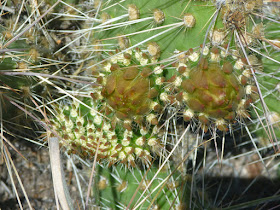 |
| Prickly pear cactus with a view: from a Hidden Valley slope over Huffaker Hills to Mt. Rose Wilderness/Carson Range |
May storms have brought late-season snowfall to the Sierra Nevada and rainfall to northwest Nevada. The Reno-Tahoe area has seen some substantial precipitation during late spring—unusual for the season. This different weather pattern resulted in a flamboyant display of flowering plants. The pictures herein show
prickly pear cacti (
Opuntia ficus) seen next to trails in Reno's
Huffaker Hills and in
Hidden Valley Regional Park; southeast of the metropolitan Reno/Sparks area.
The local low-growing variety starts its bloom with pinkish flower buds that open to yellow flowers. The typically paddle-shaped pads are green with medium to long spines.
 |
| Prickly pear cactus flower and flower buds |
As a frost- and drought-tolerant plant, opuntias make excellent contributions to xeroscaped gardens and parks designed for climate conditions in northern Nevada. The prickly pear cactus is a food plant. Culinary opuntia species have been a staple of the American southwest and Mexican diet for thousands of years. The
vegetable-like pads, the
salad-enhancing flower petals and the
mature fruits—the eponymous prickly pears, also known as
tuna—are harvested and eaten. Also, prickly pear species such as
Opuntia ficus-indica are plants of many constituents—ingredients—with various pharmacological uses [1].
 |
| Spiny pads: prickly pear nopals with spine work |
Besides enriching gardens, kitchen tables and apothecary cabinets, productive prickly pear cacti are of interest for bioenergy production. So far in small amounts, Opuntia is used for
anaerobic biogas production [2]. If the metabolism of prickly pear plants can be directed to produce lipids or oils rather than mostly carbohydrates, than they have a
bioenergy potential for arid regions such as Nevada. Prickly pears require only 20 percent of the water required by traditional crops. Respective research in biochemistry and plant molecular genetics is performed in
The Cushman Lab at the
University of Nevada-Reno [3,4].
In future, you may encounter prickly pears not only as indivual plants next to your favorite desert trail, but in cultivated communities across an agriculturally expanding desert.
Keywords:
wild opuntia,
cultivated opuntia,
food source,
pharmacology,
agronomy,
renewable energy,
biodiesel,
bioengineering.
References and more to research
[1] Sigma-Aldrich:
Nopal (Opuntia ficus-indica) [
http://www.sigmaaldrich.com/life-science/nutrition-research/learning-center/plant-profiler/opuntia-ficus-indica.html]
[2] Bruce Dorminey:
Prickley Pear Cactus: Nuisance of Bioenergy Opportunity? Renewable Energy World.Com, Tuesday, June 30, 2015 [
www.renewableenergyworld.com/articles/2014/01/prickly-pear-cactus-nuisance-or-bioenergy-opportunity.html]
[3]
UNR Reserches Sustainable Alternatives to Fossil Fuels. The Nevada Sagebrush. Tuesday, February 4, 2014; page A1.
[4] Nevada Agricultural Experiment Station:
Development Of Prickly Pear Cactus As A Low-Water Biofuel/Biomass Feedstock [
www.cabnr.unr.edu/research/research_project.aspx?GrantID=705].



Plant is opuntia polyacantha ssp. erinacea
ReplyDeletePlant is opuntia polyacantha ssp. erinacea
ReplyDeleteWhile walking in this area I may have seen these blooms in 2015. They are amazing! I would like to grow some of these above the rock wall in my backyard.
ReplyDelete